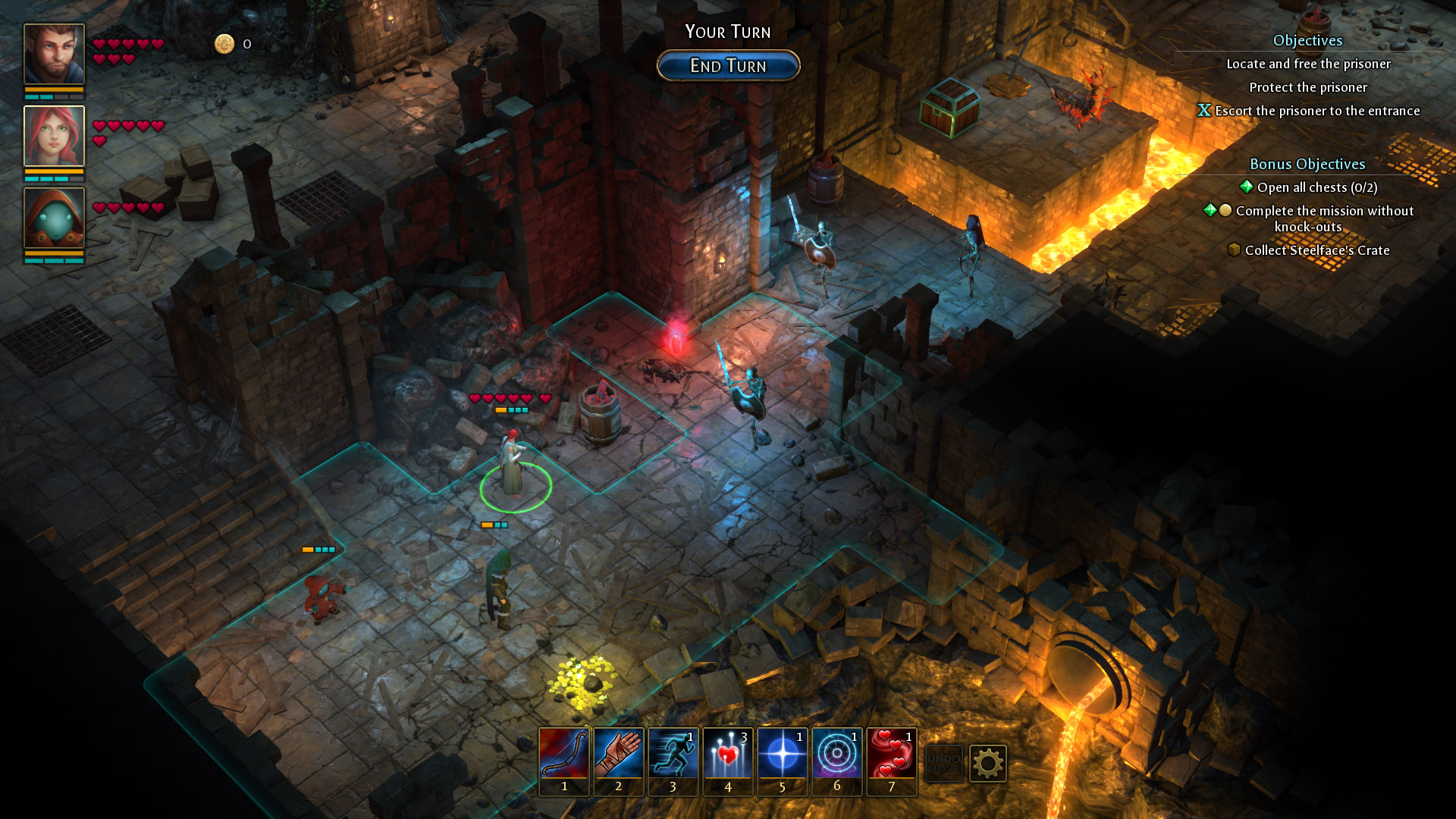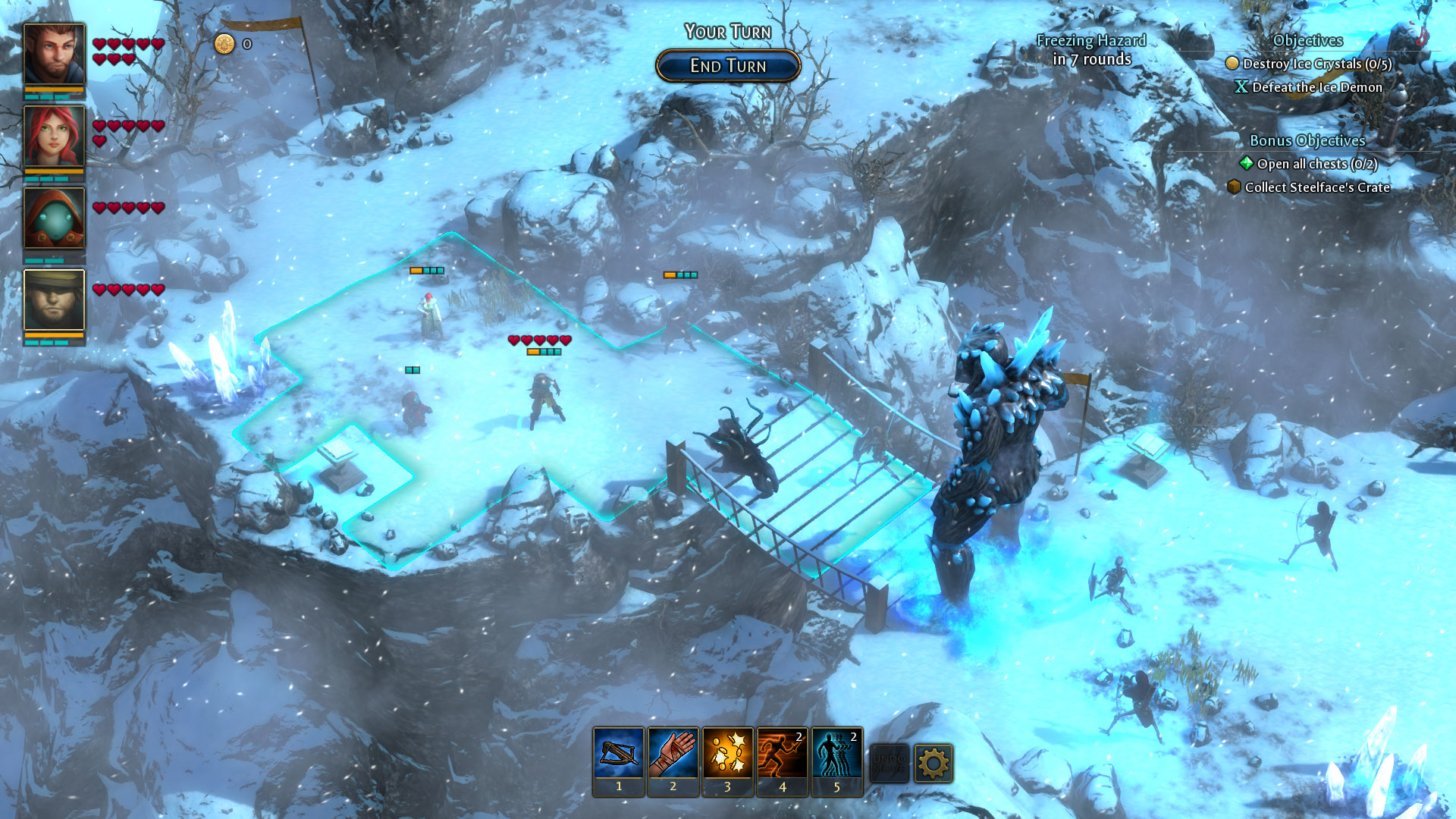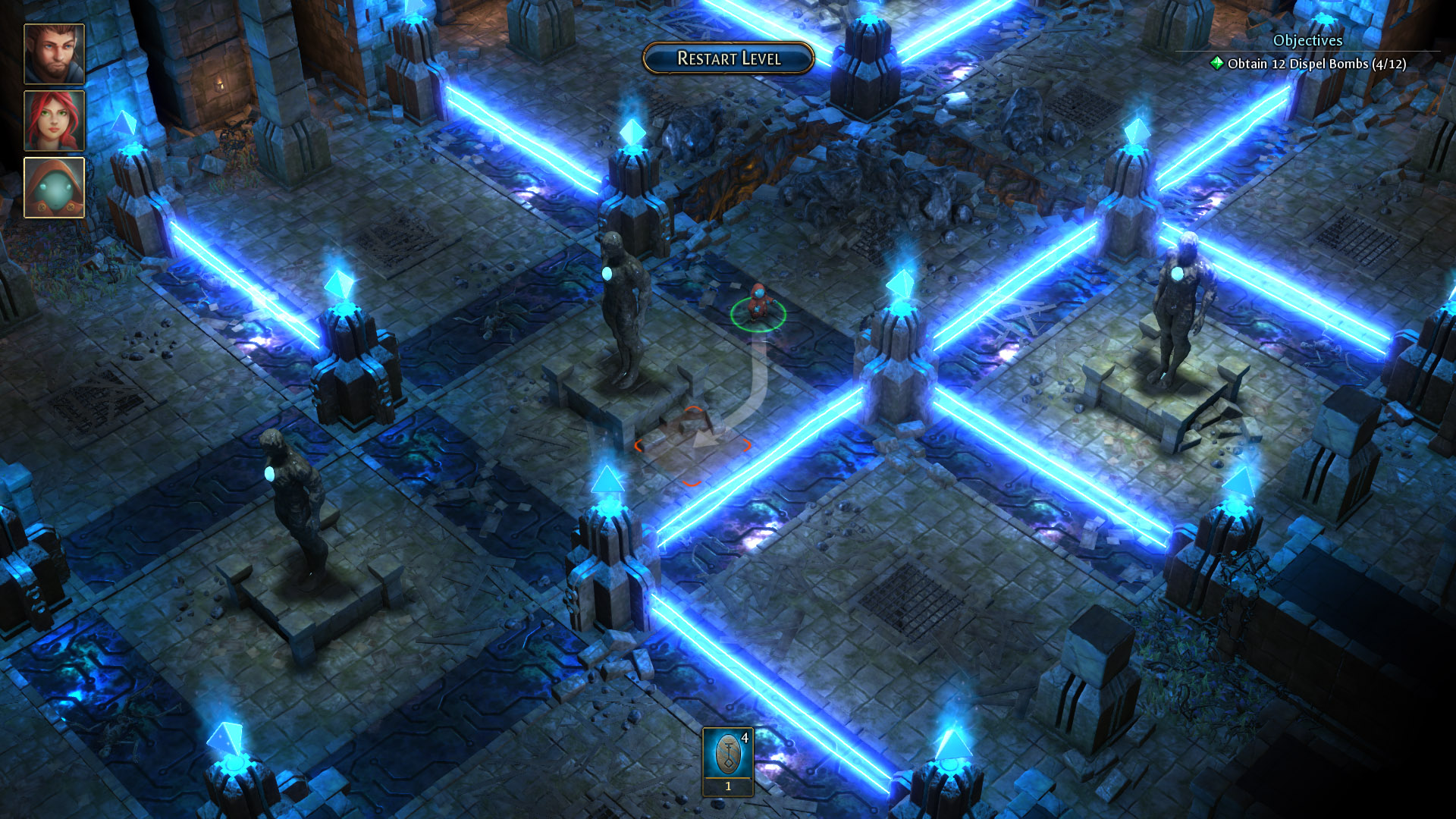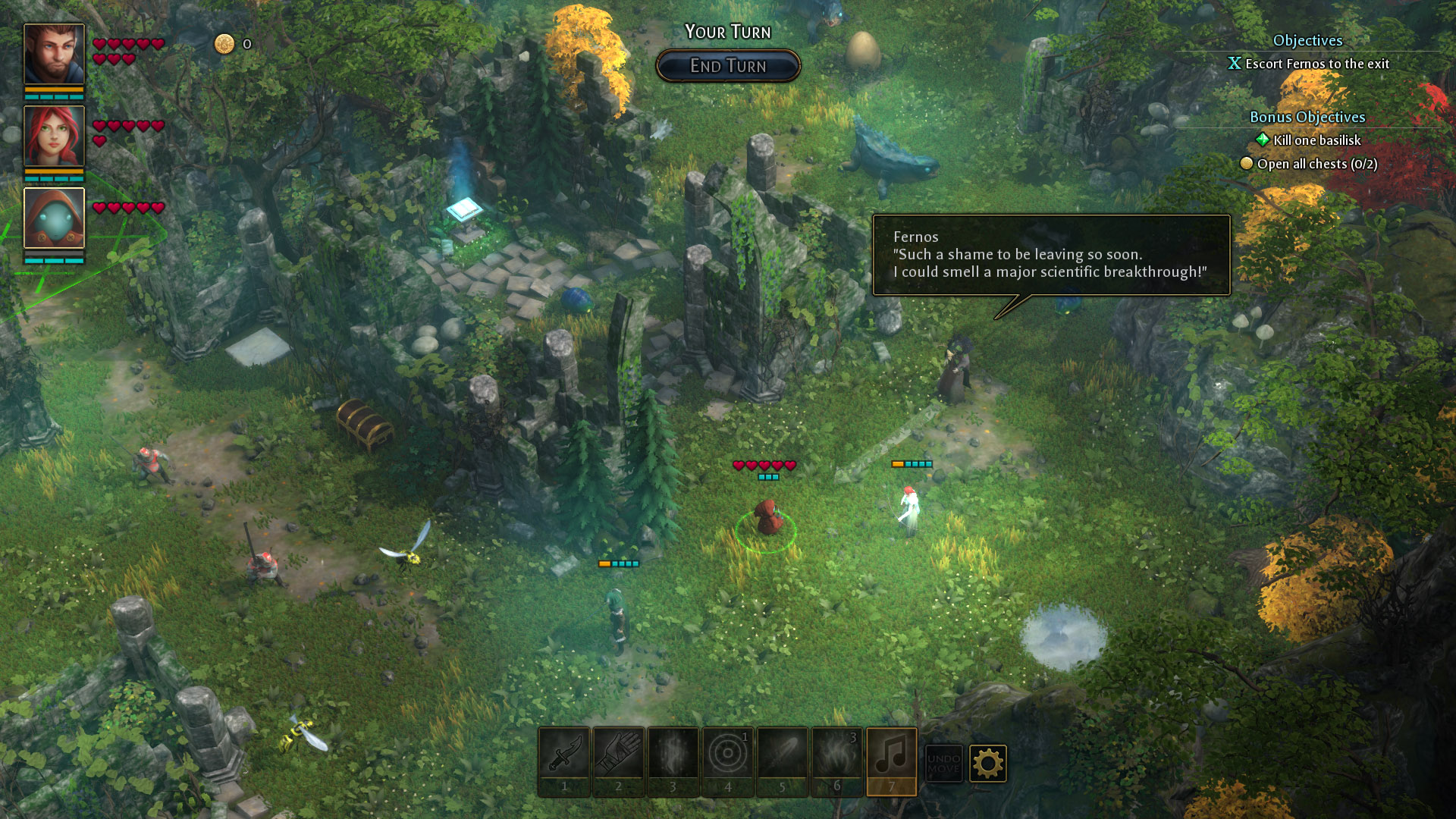From the makers of the legendary Grimrock series comes a brand new adventure. Can you uncover the secret of the Menhir Forest? read on to find out!
Type: Single-player
Genre: Adventure, RPG, Strategy
Developer: Ctrl Alt Ninja Ltd.
Publisher: Ctrl Alt Ninja Ltd.
Release Date: 15 May 2019


Druidstone: The Secret of the Menhir Forest is a labour of love from the co-creators of the critically acclaimed Legend of Grimrock series. Druidstone is a tactical, single-player, turn-based roleplaying game, which combines the best qualities of modern RPGs with the elegance of tactical boardgames. Every action, every turn counts as you control your party of heroes through handcrafted, challenging missions with varying, and often surprising, objectives.
Set in a unique fantasy world, Druidstone is filled with ancient lush forests, standing stones, snow-topped mountains, deadly creatures and puzzle-ridden ruins. And somewhere in the middle of all of this, caught in the flow of events, are Aava, the archdruid’s daughter, who must now shoulder his responsibilities, Leonhard, a warden with a mysterious past and a lethal destiny, and Oiko, the failed Red Priest who is living proof that one may be very smart without being particularly wise. Along the way, they meet companions and villains, whose unique personalities and abilities make every encounter memorable.
Introduction.
It’s in no doubt that the team at Ctrl Alt Ninja Ltd are a talented bunch. They single-handedly resurrected the dungeon crawler genre with their incredible Legend of Grimrock series. So any new title has my interest piqued from the start. Druidstone is a change of direction for the studio. It’s a turn-based role-playing game set in a new world. This is a dream project for the group. A passion for a project that melds the qualities of a board game, with all the graphical grandeur and scope, a computer-based system can yield.
The game’s development started out with procedurally generated missions, but this was dropped in favour of a more hand-crafted approach. It takes guts to change the focus of a title midway through a development cycle. I believe this new path was the right choice. The scripting elements within mission structures are cleverly implemented. Just like a top actor, they never fluff their lines and are always on cue. I’d highly doubt any auto-generated system could deliver such a tailored experience without a massive amount of quality assurance testing.

Content
The campaign is set in the mythical Menhir Forest. All is not well in this woodland glade. An Archdruid has gone dark, missing without a trace. The other druids have noticed strange things afoot, in this once peaceful land. A blight has fallen on the forest. Weird unworldly purple vegetation is spreading throughout the kingdom, causing the native habitat to morph and take on new forms. This is not good. Your job is to guide a small troop of characters in their quest to find the source of all this corruption and bring calm to the realm.
Your party is initially made of three characters. Their traits and abilities are the classic RPG archetypes; Tank, Archer and Mage. Aava plays the lead role in this adventure. after all, it is her father who has gone missing. She is skilled with the bow and also acts as a medic when things get rough. Leonhard is a defacto tough guy. Small of word and big of sword. He makes for an excellent tank /melee soldier. Oiko completes the team. He’s a wise-cracking failed red priest. For me, he is the standout member. Once his skills ramp up he can truly kick arse. His abilities rise from the initial bog standard spellcaster into a highly adaptable force of nature.

Once the opening cutscene and small tutorial mission are completed, a 3D diorama style world map is displayed. From here you can pick and choose from a couple of new adventures. Each of these is a self-contained mission. By completing these, new areas of the map are unlocked with more missions. All tasks have a main victory condition and up to three side objectives. Successful forays reward you with gold, green gems and experience points.
Gold can be spent on weapons, armour and accessories. These can be purchased at Steelface’s shop. New items can be added to the shop by finding special chests scattered around the many missions. These wares are then added to the inventory. There’s a nifty risk /reward system at play here. Hunting for chest takes a character away from the main fight and every turn is vital in this game. Players have to way up the odds. Stick to the prime objective or take a punt in order to get more high powered loot.
Green gems can be slotted into weapons, items and even character abilities. They add extra power and enhancements. These are interchangeable and not hard locked into any slot. So if you want an almighty mage then you can skew your loadout accordingly. Often missions require certain abilities in order to have half a chance of defeating the many enemies. You can easily tailor your team with the right blend of skills to be successful. I like this modular approach. Sometimes I’ve been forced to restart a TRPG once I found that one of my characters was borked with useless abilities after sinking points in a defunct part of a skill tree. This is no the case here. Kudos to the devs for implementing this system. I hope more tactics based games use this feature from now onwards.
Gaining experience points levels up your character and gives you the chance to pick from four new abilities. This is where the game shines. On the surface, three characters that portray the timeless classic archetypes might seem a bit limiting. But adding these new skills really opens up the possibilities for complex strategies in skirmishes. Oiko, on paper, is a weak mage, hopeless as a front line troop. His starting attributes are not great. He needs a full turn to meditate and focus powerful spells. After only a couple of experience levels, a whole suite of new spells can be added to his arsenal. Using a magic shield and debilitating line of sight shroud effect, he can now be a very competent buffer between your party and the onrushing hordes of darkness.

The key theme of the opening couple of missions is one of time pressure. This is implemented by a turn count down system and adds a sense of impending doom to the events. By failing to achieve the conditions within the stipulated time frame, extra enemies warp into the fray, stacking the odds of a victory heavily against the player. This is expanded by the use of environmental effects in some encounters. One episode had an imminent blizzard which caused frost damage. I’m not normally a fan of this kind of arbitrary game mechanics. I like to take my time in all games, regardless of genre. Even in fast-paced titles like Quake, I’d often take time out to admire the architecture and scenery. All this pressure adds to the impact of bad decision making. One wrong move and your party can easily be wiped out. Dynamic scripting during missions makes you think and rethink every advance into the unknown. The good thing is there is no harm in failing a quest. In fact, it’s very beneficial. Hard fought knowledge of how an encounter plays out gives the player a bit of edge when formulating new battle strategies. The ability to regroup and change your green gem slots to better suit the particular requirements of a level is a great quality of life attribute.
To change the mix and keeps things fresh. Some missions forgo any kind of combat and are straight out logic puzzles. Many of these have echoes to the Grimrock dungeon crawlers environmental conundrums. One puzzle was pure Dungeon Master territory with a room full of pressure plates, which trigger hidden marble stone pathways. Another was an interesting Tetris block puzzle using Tomb Raider-esque move mechanics. Simplistic in nature, I enjoyed these immensely as a bit of light relief between the very taxing tactical mission structures.
The press blurb describes the average game time of between 15-20 hours for completion of the main campaign. I’d wager that my time played will far exceed this conservative estimate. This due to the fact that you can replay missions if you missed or failed to get any of the side objects. The only slight penalty is that you only accrue 50% of the experience points. Replaying missions and gaining extra green gems is vital, as the later levels really test your prowess as a master tactician.

Graphics
On first glance, Druidstone reminded me of Magicka from Arrowhead studios. Both games share the same isometric viewpoint and initial verdant woodland environments. Magicka was developed using Microsoft’s XNA framework. The devs of this title decided a custom engine was required to allow for complete control of a bespoke solution. The benefits are noticeable. The game scales extremely well from budget laptop to gaming PC.
The true versatility of the codebase is highlighted whenever you invoke one of your characters powerful abilities. The camera switched from the zoomed out angle to a close-up animation. This is not a prebaked render but an actual shot from close in. All the background detail is correct and present. So for example, if one of your party is behind the focused character then they are visible, along with all the environment details of the scene. Not only is this dynamic camera system impressive, but it also allows the same 3D assets to be used universally throughout the project. This is a clever game design. It is an efficient use of studio time, which is precious within the limits of a small indie team.

Sound
The Soundtrack is composed by the good folk at Scoring Helsinki. They have delivered a great suite of musical pieces. Various tunes echo the themes of the Fire Emblem series, particularly the recent 3DS titles. One mission in which you battle skeletons and wraths harkens back to the bombastic battle scores of film titles like Spartacus and El Cid. Strident horn sections blast minor key rifts accompanied by booming timpani drums. It fits the mood of the mission well. The sense of dread that both the visuals and audio deliver is palpable.
The only fly in the ointment in the sound design is the lack of any voice work. All cut scenes and character interaction are delivered via text boxes. I know getting high-quality actors for any title bumps up the development cost exponentially, but this would have taken the presentation of the game to a whole new level. Wayne June’s narration in the Darkest Dungeon is a classic example, where the tone of the project is lifted from workmanlike to best in class.

Difficulty curve
All through the visuals and general aesthetics look inviting. Druidstone‘s difficulty level is not for the faint of heart. I’ve played many many tactical RPGs going right back to the ancient Gameboy titles such as Tactics Ogre, Shining Force and Advance Wars. Playing the first few scenarios on normal difficulty, I was, to be blunt, getting my arse slapped by the game. Reading the Steam forums I found I was not alone in this predicament. The devs have deliberately skewed the challenge towards rock hard. This is no “my first strategy game” complete with rainbows and fluffy Chocobos. Even grizzled veterans like myself have been reaching for an adult beverage, after a few hours of getting beat down by rabid wolves and massive rats.

Quality Of Life Features
One strange omission is the support for any Steam cloud saves at the time of this review. During my test process, I use several different computers depending on my location. I’d taken this feature for granted until now. They have been promised in a future update, but It’s a bit of pain to manually copy data file from the depth of your Steam library folder from one system to another.

Forthcoming support.
The game was created with a new editor custom coded to make the content generation as easy as possible. The original roadmap was to have this bundled with the release of the title on Steam. Unfortunately, due to time pressure, this is not the case. Forum posts have hinted at a post-launch release via an update. This new editor looks far more intuitive and powerful than the previous one that supported the Grimrock games. Even if the devs move on to the next project, this editor, in the hands of a talented user base could be the portal to endless amounts of new missions and campaigns to enjoy. Integrated Steamworks support would be the cherry on the cake. Fingered crossed that this process is brought to fruition soon.

Verdict
Druidstone is an interesting beast. The development studios DNA is very evident in all components of the title, even though this is a slight departure from their previous work, they are so many parallels in game mechanics and general art design. The move from a first-person viewpoint to an isometric camera is the only big departure apart from the established turn-based approach. The real strength of the game is the combat system and the modular nature of the gem slots. Character abilities can be fine-tuned for specify missions. The game really shows its teeth once you have a full roster of skills for your main characters. The amount of customisation is excellent and impressively diverse. The sweet sauce is combining all these ingredients into a good fighting unit. The result is a deeply satisfying tactical experience and yet another quality game from the Ctrl Alt Ninja druids.










